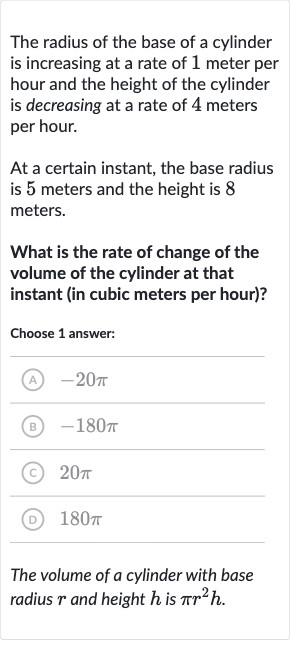AI tutor
Welcome to Bytelearn!
Let’s check out your problem:

The radius of the base of a cylinder is increasing at a rate of meter per hour and the height of the cylinder is decreasing at a rate of meters per hour.At a certain instant, the base radius is meters and the height is meters.What is the rate of change of the volume of the cylinder at that instant (in cubic meters per hour)?Choose answer:(A) (B) (C) (D) The volume of a cylinder with base radius and height is .
Full solution
Q. The radius of the base of a cylinder is increasing at a rate of meter per hour and the height of the cylinder is decreasing at a rate of meters per hour.At a certain instant, the base radius is meters and the height is meters.What is the rate of change of the volume of the cylinder at that instant (in cubic meters per hour)?Choose answer:(A) (B) (C) (D) The volume of a cylinder with base radius and height is .
- Volume Formula: The formula for the volume of a cylinder is . We need to find the rate of change of the volume, which is .
- Chain Rule Application: To find , we use the chain rule from calculus: .
- Calculate : First, we find which is the derivative of with respect to . .
- Calculate : Then we find which is the derivative of with respect to . .
- Find and : Now we plug in the values for and . is meter per hour and is meters per hour.
- Plug in Values: We also plug in the values for and at the instant we are considering. is meters and is meters.
- Calculate : Now we calculate using the values we have. .
- Simplify Expression: Simplify the expression. meters/hour + meters/hour.
- Combine Terms: Combine the terms to find the total rate of change of the volume. meters/hour.
- Final Result: Simplify the result. meters/hour.
More problems from Area of quadrilaterals and triangles: word problems
QuestionGet tutor help
QuestionGet tutor help
QuestionGet tutor help
QuestionGet tutor help
QuestionGet tutor help
QuestionGet tutor help
QuestionGet tutor help
